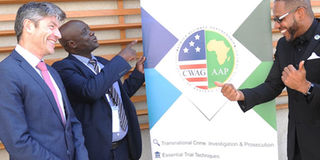Poisons Board to take war on fake drugs mobile

The Pharmacy and Poisons Board CEO Fred Siyoi (centre) and CWAG AAP Board Member Markus Green when they announced plans to use mobile phone technology in bid to end the scourge of counterfeit medicines in Kenya on February 6, 2019. PHOTO | COLLINS OMULO | NATION MEDIA GROUP
What you need to know:
- Pharmacy and Poisons Board boss Fred Siyoi was speaking at a workshop on combating counterfeit drugs in Nairobi.
- Mr Siyoi said the board is working with software developers and the short message code is being tested before launch mid this year.
- The counterfeit conference convener said 100, 000 deaths in Africa are linked to counterfeit medicines.
Kenyans will soon be able to use their mobile phones to identify whether the medicines they take are genuine.
This comes after the Pharmacy and Poisons Board announced it is working with software developers to create a unique code that will be used to identify the quality as well as track across the supply chain all medicines in the country — imported or locally manufactured.
The Board’s Registrar and chief executive Fred Siyoi said that a short message code is being tested and is set for roll out mid this year.
He said that the health safety code will available for Kenyans at chemists, clinics and other health facilities.
“At the patient’s level, they will be able to tell if it is genuine paracetamol, its side effects, the pharmaceutical it has been dispensed from and whether it is registered using the unique identifier number and a code.
“Currently, it is being developed and we have started its trailing. Once the trailing is done, we will launch it within the year,” said Mr Siyoi.
CODE TESTING
Mr Siyoi was speaking on Wednesday during a three-day workshop on combating counterfeit drugs organised by Conference of Western Attorneys-General Africa Alliance Partnership (CWAG AAP) at Radisson Blue Hotel in Nairobi.
“Deployment of new technology to help track the drugs is the only solution seeing that the criminals are always a step ahead of us. So we have to rely on technology to nab them,” he said.
Mr Siyoi said 80 percent in the Kenyan market are imported.
“Whenever there is shortage of drugs as there was with snake venom, people take advantage to create something to meet the gap,” he said.
GPS MAPPING
But he said the board has put up measures to reverse the trend, including GPS mapping of registered pharmacies, incorporating new technologies such as online licensing and reporting system, having drug inspectors at ports of entry and carrying out product registration and evaluation to check all drugs entering the market.
This is in addition to regular inspection of manufacturing sites and collaborating with the Anti-Counterfeits Agency, Directorate of Criminal Investigations, Interpol and World Health Organisation.
“We have deployed various types of technology like spectrometer (the portable device that scans medicines for active ingredients). If there is no active ingredient, we confiscate the drug and issue an alert wherever the drugs and they are seized or quarantined or destroyed,” he said.
On his part, CWAG AAP board member Markus Green said a WHO report revealed that 25 percent of drugs in developing countries are either falsified or sub-standard, with 100, 000 deaths per year in Africa linked to counterfeit drugs.
Mr Green said 50 percent of medicine bought on the Internet from illegal sites that conceal their physical address have been found to be counterfeits.
He said counterfeiters prey on the poor.
“Their only objective is to make money and they do not pay attention to the people they are selling to. The drugs have no medicine in them or have chemicals that one should not ingest. This can cause death but we are making sure that the consumer is educated on what a counterfeit is and what is real,” said Mr Green.





